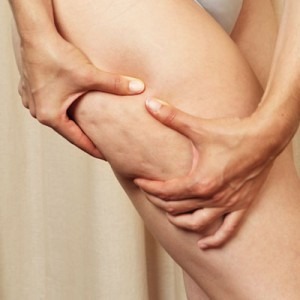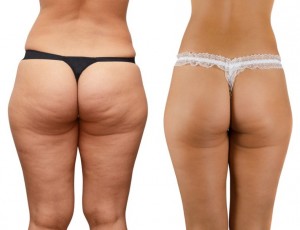 Cellulite…although kind of “catchy” as a word, is definitely not something that anyone wants associated with their bodies.
Cellulite…although kind of “catchy” as a word, is definitely not something that anyone wants associated with their bodies.
In plain, simple terms, cellulite is a type of stored fat tissue. Inside this fat tissue is connective tissue that protects our muscles and organs. However, when fats, fluids and toxins get trapped in this connective tissue they harden and create pockets that appear through the skin as dimples. This is cellulite. Now, dimples on people’s faces are attractive but dimples from cellulite…not so much!
Unfortunately for women, cellulite occurs more often due to the circular shaping of their fat cells. Cellulite usually occurs after puberty and the thighs, buttocks, breasts and abdominal areas are the areas that are most often affected.In fact, studies reveal that nearly 90% of women are effected by cellulite at some point in their lives and it doesn’t even matter if they are slim and relatively fit. On the other hand, only about 10% of men suffer cellulite.
Although cellulite is a condition that does not have any real adverse effect on your health, it could possibly be a signal that you are practicing an unhealthy lifestyle.
So, what causes cellulite? There are numerous different causes of cellulite, but the major ones are:
Poor diet. Diets that are high in fat block arteries and allow fat to get caught in the connective tissue.
Lack of exercise. Exercise gets our blood flowing, when we don’t exercise we don’t get enough blood circulation to wash toxins out of blocked tissue. Rarely will you find any cellulite “dimpling,” “orange peel,” or “cottage cheese” on ballet dancers or women athletes.
Hormones. Not surprising as hormones are major players in our health. Estrogen, insulin, noradrenaline, prolactin and thyroid hormones have all been connected with cellulite production.
Lifestyle. Those who consistently sit or stand in the same position for extended periods of time are likely to experience cellulite as well as smokers.
Clothing. Believe it or not, even clothing can cause issues with cellulite. Underwear that pulls tight elastic across the butt can even contribute to the formation of cellulite. It’s always best to wear loser fitting undergarments without tight elastic to avoid forming cellulite in the first place.
It’s not surprising that exercise is effective in reducing cellulite on a number of levels. Sitting still burns no calories, while exercising your body will burn up to 15 times more calories and, as an added bonus, the body continues to burn calories six to ten times faster for up to twelve hours.
Without a doubt, proper strength training is a very effective and inexpensive way to smooth out those unwanted cellulite bumps and lumps. The more often and regularly you work-out, the sooner your cellulite problem is reduced and can even be prevented in the future.
The more often and regularly you work-out, the sooner your cellulite problem is reduced and can even be prevented in the future.
Strength training exercise not only helps rid your body of unsightly cellulite, but you’ll gain lean muscle tissue in the process too that continues to burn calories even after you’re done working out because muscle is a metabolically active tissue which means that the more it is used the more calories are burned.
When you exercise, at least five times more blood flows through your arteries and veins. It helps to stimulate circulation and boost the lymph flow which does not have a pump to propel it around the body but relies on the contraction of muscles to push it along.
Avoiding cellulite is not different than treating other medical conditions. It’s ultimately important that your diet consists of low fat food such as vegetables and fruits along with fiber.
For more tools and resources from Carolyn Hansen to assist you in attaining your goals and achieving the success you desire in life, please visit:
